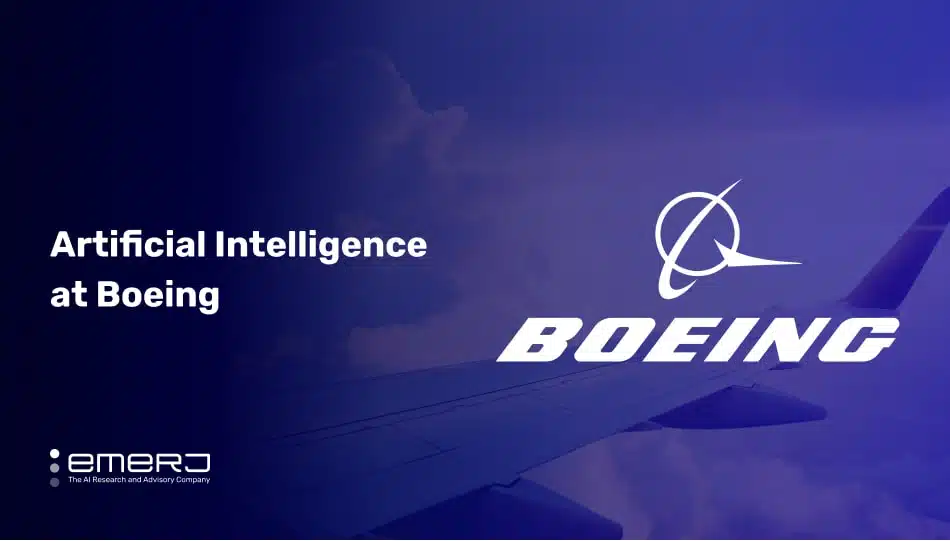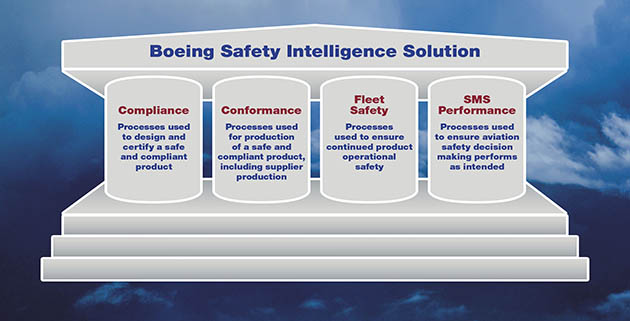Boeing, founded in 1916, is a global aerospace company and one of the largest aircraft manufacturers in the world. Headquartered in Arlington, Virginia, the company operates in commercial airplanes, defense, space, and security sectors.
In 2022, Boeing reported revenues of $66.6 billion, a significant increase from $62.3 billion in 2021. However, the company faced a net loss of $5.1 billion in 2022. As of 2023, the company’s revenue was $77.794 billion, and the net loss was $2.222 billion.
These figures represent an increase in revenue but a continued net loss for Boeing in the 2023 fiscal year.
While specific overall AI investment figures are not publicly available, Boeing has made strategic moves in this area. These include a $50 million commitment to AEI HorizonX’s second venture fund in 2022, which partly focuses on AI-related startups, and a 2017 investment in SparkCognition, an AI company.
Boeing’s AI initiatives span various sectors, including autonomous flight technologies, urban air mobility solutions, and advanced AI for unmanned systems, demonstrating the company’s commitment to maintaining its position at the forefront of aerospace innovation.
This article explores two compelling use cases that illustrate how Boeing’s AI initiatives are actively supporting its strategic business objectives:
- Managing spending with generative AI (GenAI): Implementing GenAI-powered solutions to automate sourcing, analyze spend patterns, and facilitate competitive bidding to reduce costs and improve decision-making, particularly for low-value, high-volume purchases.
- Addressing safety risks with predictive data models: Leveraging data integration, advanced modeling, and machine learning to identify potential hazards before they become critical issues.
Utilizing Gen AI for Spend Management
A research paper by the Technical University of Košice, Slovakia, explains the traditional array of several supply chain challenges the aerospace industry faces. These include coordinating complex multi-tiered networks, long lead times, and managing high-value components. Aerospace players must meet stringent quality standards while adapting to rapid technological changes and managing global operations.
Additionally, an average American commercial aerospace company has more than 12,000 tier-2 suppliers, as reported by Deloitte, which creates a network of thousands of suppliers to manage.
While speaking at the ISM World conference in Las Vegas, Tiffany Andrews, senior manager at Boeing’s Indirect Procurement Center of Excellence, expressed that Boeing faced some similar challenges in its procurement processes, particularly in managing the vast amount of data associated with its supply chain.
As reported by the Supply Chain Management Review, Boeing needed to improve efficiency, reduce costs, and enhance decision-making in its procurement operations.
“We had catalogs in our systems, but anything that wasn’t on a catalog that was strategically placed was considered a SPO or a one-time, and we didn’t have a great handle on that,” Andrews said.
At the same conference, Andrews mentions about Boeing’s partnership with Fairmarkit, an AI technology provider to develop and implement an AI-powered solution for procurement optimization. Fairmarkit is an AI-powered procurement platform that automates and claims to optimize sourcing processes, particularly for tail spend management, to increase efficiency and reduce costs for organizations.
Fairmarkit’s solution, Tail Spend, which Boeing adopted, is a spend management solution that automates the sourcing process for low-value, high-volume purchases and uses AI to analyze spending patterns and suggest suppliers.
Here is a brief one-and-a-half-minute video demo of how the Tail Spend works:
According to the video demo, the workflow of Fairmarkit’s tail spend management solution is divided into five key points:
- Requisition Creation: A buyer initiates a purchase requisition in their existing e-procurement system.
- Supplier Identification & RFQ Generation: Fairmarkit identifies relevant suppliers and generates a Request for Quote (RFQ) to send to them.
- Supplier Bidding: Suppliers submit their bids through the Fairmarkit platform, which consolidates all responses for comparison.
- Bid Analysis & Recommendation: The platform analyzes the bids and recommends the best supplier based on various criteria.
- Order Creation & Data Synchronization: After buyer approval, a purchase order is created in the e-procurement system, and data is synchronized for tracking and analytics.
Andrews also explained at the ISM Conference that Fairmarket would consolidate data from both the old and current systems to analyze spending trends. The consolidation would reveal patterns in the company’s spending habits and highlight its most frequently used suppliers.
While neither Fairmarkit nor Boeing has publicly announced the results or the business outcomes of this partnership, Fairmarkit states that their platform has helped MBTA, their customer, with $100,000 in monthly savings.
They also claim to reduce source-to-award cycle times, with Emirates Flight Catering reportedly reducing their cycle time by 85%. Boeing had initially rolled out the Fairmarkit platform in India but is now going for global adoption, suggesting that the solution is scalable and adaptable to different regional procurement needs.
Addressing Safety Risks with Predictive Data Models
In the wake of a series of high-profile safety incidents in 2018-2019, Boeing intensified its focus on preventing accidents and improving overall safety. According to a 2022 press release, the company’s Chief Aerospace Safety Officer (CASO) is now spearheading a new initiative with a mission to “Drive aerospace safety to prevent accidents, injury or loss of life.”
Boeing’s new safety strategy centers around the concept of “predict to prevent.” This approach involves:
- Data Integration: Collecting and analyzing vast amounts of data from various sources across the aerospace industry.
- Advanced Modeling: Utilizing system engineering and accident causation models to identify potential hazards.
- Machine Learning: Employing AI and machine learning algorithms to detect patterns and anomalies in the data.
- Cross-functional Collaboration: Bringing together experts from different disciplines to interpret and act on the insights generated.
The new Boeing Safety Intelligence Solution is built on four pillars:
- Compliance
- Conformance
- Fleet Safety
- SMS Performance
Screenshot from Boeing Predict to Prevent (Source: Boeing)
“The first three-run parallel to Design, Build and Operate. The fourth is about how well the SMS is functioning in the real world,” said Vishwa Uddanwadiker, safety analytics lead in Boeing’s Chief Aerospace Safety Office (CASO), in the previously mentioned interview published by Boeing on its website.
As reported by Bloomberg in one of its articles, Boeing’s safety management system collects and monitors data from an array of internal and external sources, like design and manufacturing data, audit findings, and even reports that repair stations file to flag failed and malfunctioning parts to the Federal Aviation Administration.
In the same article, Uddanwadiker mentioned that earlier this year, the company began using a machine-learning algorithm that it developed jointly with the FAA to scan and mine data from the so-called “Service Difficulty Reports” for worrisome risks emerging within the global fleet. They’re written accounts of parts breakdowns that are filed by the maintenance shops and are not easily categorized.
The article also states that the safety team at Boeing tracks 20 key performance measures on a weekly basis that are closely correlated to safety risks in designing, building, or operating its aircraft.
Despite Boeing’s efforts to overhaul its safety management systems through the “predict to prevent” initiative launched in 2022, the subsequent years have seen a series of safety incidents that starkly highlight the ongoing challenges in the company’s safety practices. What was intended to be a transformative approach—leveraging AI and machine learning to detect potential risks—has seemingly fallen short, culminating in a catastrophic year for Boeing in 2024.
While Boeing initially integrated advanced data models and cross-functional collaboration to anticipate and mitigate safety hazards, the surge in incidents, as reported by Business Insider, has cast serious doubt on the effectiveness of these measures.
The company has endured enormous criticism for how it handled its safety failures. As major news outlets have extensively covered, the disconnect between Boeing’s proclaimed safety reforms and the harsh reality of its ongoing safety woes has left the company grappling with a severe loss of public trust and scrutiny over its management decisions.
A number of company executives have been dismissed – including CEO Dave Calhoun’s decision to leave the company after 2024 – in an effort to hold Boeing leadership accountable. However, it’s noteworthy that Vishwa Uddanwadiker, the safety analytics lead overseeing this initiative, was moved to the role of Chief AI Officer in March 2024. Much of the public criticism of Boeing has focused on company culture rather than specific safety protocols or data gathering initiatives, and Uddanwadiker’s continued tenure with the company appears to reflect that.
In terms of the applicability of the technology at hand to drive safety in aerospace initiatives, more generally, documentation from NASA’s System Wide Safety Project mentions that machine learning helps in aviation safety by enhancing data analysis capabilities and improving anomaly detection. It also states that by integrating data from multiple sources and providing real-time monitoring, AI and ML offer a more comprehensive and up-to-date understanding of airline operations.





















